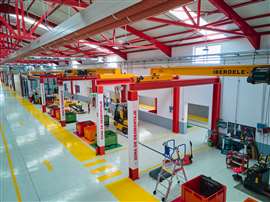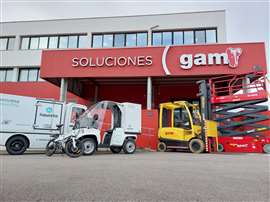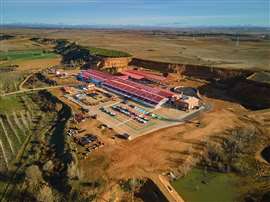GAM’s Reviver plant promises sustainable solutions to customers
03 October 2024
GAM says its new Reviver equipment refurbishment plant will extend the life of machines and reduce fleet CapEx. Diego García Pastor, managing director for Spain, tells IRN how.
One of the top priorities for Diego García Pastor, managing director of GAM Rentals in Spain, when he took on the role earlier this year was to increase the company’s focus on electrification and offer more
 Diego García Pastor, managing director for GAM in Spain. (Photo: GAM Rentals)
Diego García Pastor, managing director for GAM in Spain. (Photo: GAM Rentals)
ustainable solutions to its customers.
At the time of writing, 83% of GAM’s fleet is electric, which the company considers a “unique value proposition” in the markets it operates in, as demand for electric machines continues to rise.
The company’s sustainability goals took a major step forward last year with the opening of its Reviver plant, which refurbishes machines in its fleet to give them a longer lifespan.
Based in Villacé, in the North West of Spain, the 200,000m² facility began trial operations in December and is currently retrofitting two units per day.
“We just hit the landmark of finishing the first 100 units since we launched the project,” Garcia Pastor tells IRN during a recent video call. “It’s still the early stages, but we’re making good progress. We’re very happy and believe this is the future.
“We see the need to develop sustainable solutions in all aspects. What we are trying to implement is relatively new for the industrial machinery industry, but when we look at other industries, it is not new.”
The facility, a ‘second life site’ repurposed specifically for the project, is currently focused on retrofitting forklift trucks.
When fully operational, it will have the capacity to rebuild 3,000 units a year. García Pastor, who joined the company in 2023 as director of business development, explains that the project aims to bring the circular economy to the industry.
“With these 100 units that we have been able to remanufacture so far, we are able to obtain an emissions reduction ranging somewhere between 70% to 75%, which is phenomenal if we compare it to the emissions that would be created if you were to build that machine from new.
“That’s our contribution to develop a new model, a new concept and to help our customers in their objectives to reduce emissions, which I think is something important for our customers and important for society.”
Fleet utilization
Another driver for the plant was to reduce CapEx in its fleet. In its results for the first half year, the company reduced its capital investment by 40% to €29.8 million.
“That doesn’t mean that we’re not going to invest on new equipment,” he says. “We do invest every year heavily on new equipment, especially for long-term rental contracts, but specifically on the short-term rental
 When fully operational, the Reviver plant will have the capacity to rebuild 3,000 units a year. (Photo: GAM Rentals)
When fully operational, the Reviver plant will have the capacity to rebuild 3,000 units a year. (Photo: GAM Rentals)
fleet I think a good amount of the fleet would be not bought new but will be remanufactured.
“How much exactly, it’s still early in the project for me to answer that specific question. For us right now, we’re working on the plan for 2025 and we do expect a significant reduction in the original plans that we had with respect to the investments on short-term rental fleet.”
As for its existing fleet, García Pastor thinks a large part will go through the Reviver process. Initial trials have so far focused on its material handling segment, but the next step will be to start retrofitting its aerial equipment lineup (which represents 34% of its fleet). That will start at some point in the second half of this year.
“We have gone into more conventional types of forklifts, but the factory itself has the capacity to go all the way to what we call big trucks and also to elevation equipment. We will certainly be doing platforms and there are other different types of equipment.”
The process of selecting which machines are to be retrofitted is decided by a variety of factors, he says, with the key criteria being the type of machine and whether it has demand in the market.
“It makes no sense for you to remanufacture units that you will not be able to rent later on to your customers,” he states.
“Do we have a demand for such a machine? Do we have access to all the parts that are required? Do we have the knowledge and expertise? There’s also the cost aspect. If the remanufacturing is too costly then it doesn’t justify it. These are the criteria that we consider.”
Another factor is the volume of machines, with the process requiring somewhere between 10 to 30 units, depending on the machine type.
“We don’t do remanufacturing of one unit at a time. We have minimum lots of remanufacturing units, which varies depending on the type of unit.”
He says simpler units are easier to retrofit, but more complex ones take more time, which means the company requires a larger batch for such units.
 Initial trials at the GAM Reviver plant have so far focused on material handling equipment, but the next step will be to start retrofitting the aerial equipment lineup. (Photo: GAM Rentals)
Initial trials at the GAM Reviver plant have so far focused on material handling equipment, but the next step will be to start retrofitting the aerial equipment lineup. (Photo: GAM Rentals)
In terms of how long a machine’s life can be extended, he says the company doesn’t have “quantitative data,” but the concept is that when each unit is remanufactured the performance should be the equivalent to a new one and the life of the components should be the same as if it was a brand-new model that the company issues.
As for the cost of remanufacturing units, he says it is difficult to generalize and depends on the condition of each individual unit.
He also reveals the company doesn’t currently retrofit diesel units to electric or vice versa; “Eventually, would we be able to consider the changing of technologies of going from a combustion unit to electrical unit? Technically it’s possible, but you’ve got to say, certification of that machinery will have to be recertified, and that’s something that today we are not doing.”
Overseas opportunities
Another notable change for GAM in recent years is its growth overseas. Outside of Spain it has operations in Portugal, Saudi Arabia, Morocco, Mexico, Chile, Peru and the Dominican Republic.
The company reported a 10% increase in revenues to €143.3 million for the first half of 2024, with Latin America, which grew to reported a 43% increase to €24.1 million, among the fastest growing regions.
Elsewhere, operations in Morocco and Saudi Arabia were up 78% at €4.8 million, while Spain was up by 3%.
The above means that sales outside Spain now account for 35% of its business, although the ultimate goal is to have 50% of its revenues come from overseas, he says.
That gradual increase comes after what García Pastor says was a focus for the business to grow its presence abroad coupled with more of its customers, especially in Europe, closing manufacturing operations.
“As a result of that we are seeing big investments going on in certain markets, specifically Mexico and Morocco. Those are markets that we’re seeing big growth of industrial investments by multinational companies. These are good opportunities for us because these are markets where we are present - automotive industry or logistic operators.
“Saudi Arabia is also seeing tremendous growth thanks to the investment projects going on in the Kingdom. We feel that we’ve got opportunities to grow in all those markets.”
Looking ahead, he says an overseas Reviver plant is “an option we would consider” in response to growing demand but admits that its immediate focus is on consolidating the concept, which currently sees the machines distributed to Spain and Portugal.
“The best way to achieve that is in a market where we have got a big concentration of units and a large base of customers. Then, with all that experience and know-how and references, can we maybe consider the possibility of doing the same thing elsewhere? Mexico, Saudi Arabia? I don’t know. Why not? It’s a possibility that we’ve discussed internally but today it is not more than a concept.”
M&A plans
Aside from the Reviver plant, GAM has been active in the acquisitions space for some time, most recently last year when it acquired Valladolid-based Carretillas Mayor and Mexican rental and sales company Ozmaq.
 Aerial view of the 200,000m² Reviver plant in Villacé, in the northwest of Spain: (Photo: GAM Rentals)
Aerial view of the 200,000m² Reviver plant in Villacé, in the northwest of Spain: (Photo: GAM Rentals)
“Yes, there are,” he says when asked whether there are any further M&A plans. “We are constantly analyzing new opportunities both here in Spain and abroad. I don’t think we will see any this year, but it’s very likely that in 2025 we will see some of those opportunities that we are now negotiating materializing.”
As for entering new markets, he isn’t ruling anything out, but says the focus is on trying to grow in existing markets; “If an opportunity comes about in a market where we are not present, maybe an organic growth opportunity, we will look into that, but it has to be very, very attractive in order for us to really consider.” He adds that any moves will likely be for companies that “complement our current lines of activity.”
STAY CONNECTED



Receive the information you need when you need it through our world-leading magazines, newsletters and daily briefings.
CONNECT WITH THE TEAM







